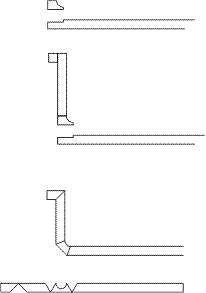
Design Watch:
There are situations where one technique will be more desirable (cost, limitations, etc.) than the other.
Curved walls are difficult, but not impossible for the "coved inlay" method. There will be radius limitations with this.
A small recess is routed into (out of?) the deck at the back, and a cove routed piece of solid surface is inserted into it. Add a vertical splash length to it for a determined splash height, and a scribe for fit to walls.
V-grooved, or miter-fold cove
A cutterhead can be shaped to cut into the material, which is then folded up into a coved piece. A standard V-groove cut can be made on the reverse side for a scribe piece.
Coved inlay splash (or coved inlay), rolled splash (a misnomer), miter-fold splash.
Description: See the individual descriptions to left.
Variations: There are a variety of cutterheads to give you many different sizes of cove, however, the 3/8" radius seems to be the best.
There are also pre made splashes that insert into the splash, similar to the coved inlay style, but we do not recommend this technique, as there is virtually no way to guarantee a color match.
Applications: A coved splash can be used anywhere a watertight seam is wanted at a direction change. Examples: backsplashes, coved floor base, wet wall vertical corners, etc.